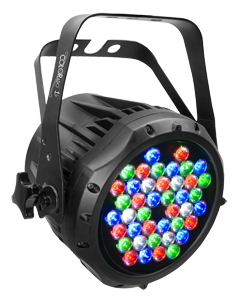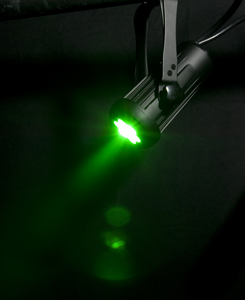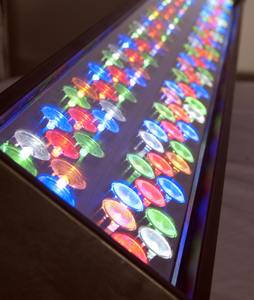Tech Talk: Don’t Ignore Preventative Maintenance
Posted on March 28, 2012Written by Mike Graham, product manager for CHAUVET Professional
Keeping your equipment running is critical in this day and age. No one can afford to have a broken fixture just sitting there collecting more dust than if it were in the rig. Scheduling preventative maintenance protects your investments and brings more money in the long run. Depending on your environment and on how much you are using your lights, you should plan for a preventative maintenance usually once a quarter. If your lights perform in a particularly harsh environment, then it would make sense to do it twice or more a quarter.
1. Exterior inspection. This is the easiest to do, and to be quite honest, should actually happen every time you pack for a show. Watch for these steps when conducting the inspection:
 A. Cable and connection check: check that all of the connections are tight and that the power connector holds the power cable correctly. If it is not locking properly, or is falling out, then it may be time for a new connector. Make sure your DMX connections are sung, but don’t let the cables hang up when you are trying to release them. If you have tails coming from the light, inspect the cable strain relief to make sure it is not cracked. Also, verify that the wire and the connections are in good condition.
A. Cable and connection check: check that all of the connections are tight and that the power connector holds the power cable correctly. If it is not locking properly, or is falling out, then it may be time for a new connector. Make sure your DMX connections are sung, but don’t let the cables hang up when you are trying to release them. If you have tails coming from the light, inspect the cable strain relief to make sure it is not cracked. Also, verify that the wire and the connections are in good condition.
B. Fan vent inspection: if your lights have fans, then there are fan vents. If the fan vents look like the lint trap on your dryer after you run a load of towels, then it is time for a cleaning! This can be done with a rag slightly moistened with glass cleaner.
CAUTION! Never spray any kind of cleaner directly onto a fixture. Always spray it on a towel or rag, and then rub the fixture clean. NEVER use an air hose or caned air to blow into the fan vents. Spinning the fans may sound cool, but can create a positive voltage feedback into the main PCB and will for sure damage the bearings on the fan itself.
C. Optics inspection: take a look at the lens and make sure it is free of garbage. Again, a little glass cleaner goes along way. Do not use anything abrasive to clean glass. It will scratch and you will cry. While you are looking into the optics, check and make sure that there is no apparent heat damage on anything under the glass.
 2. Internal inspection. On any product that has a fan, internal inspections are important. For IP outdoor rated products, this is completely not necessary. Keep in mind that only qualified personnel should open IP products. Opening up a COLORado 1 IP is easy. Getting it back together and maintaining the IP rating is tricky. Also, opening up an IP rated fixture will void the warranty.
2. Internal inspection. On any product that has a fan, internal inspections are important. For IP outdoor rated products, this is completely not necessary. Keep in mind that only qualified personnel should open IP products. Opening up a COLORado 1 IP is easy. Getting it back together and maintaining the IP rating is tricky. Also, opening up an IP rated fixture will void the warranty.
A. Cable and connection check: visually assess the inside of the light to make sure that all of the connections are attached properly. You can give them a little wiggle—not a tug—to verify that they are not falling off. Make sure that no cables are pinched and that they are still flexible.
 B. Fan cleaning: always clean fans before you clean your optics. Once the head covers are off, you will see that you have a rat’s nest of hair, dust, dead skin cells, haze or fog fluid, and other nasty stuff stuck to your fans and heat sinks. To get this off, first put on a mask. You do not want to breath in the dust bunnies that you are about to blow out of here. If you are working on a fixture with an exposed lamp, such as a typical 250-watt or 575-watt moving head fixture, you may want to remove the lamp to avoid having dust stick to it. It’s not so much that the dust will start on fire when you turn the lamp back on, but it will stink as it burns off. So, to make it simple, just follow these steps:
B. Fan cleaning: always clean fans before you clean your optics. Once the head covers are off, you will see that you have a rat’s nest of hair, dust, dead skin cells, haze or fog fluid, and other nasty stuff stuck to your fans and heat sinks. To get this off, first put on a mask. You do not want to breath in the dust bunnies that you are about to blow out of here. If you are working on a fixture with an exposed lamp, such as a typical 250-watt or 575-watt moving head fixture, you may want to remove the lamp to avoid having dust stick to it. It’s not so much that the dust will start on fire when you turn the lamp back on, but it will stink as it burns off. So, to make it simple, just follow these steps:
Step 1: make sure your fan is not going to spin freely. Use a screwdriver to put threw the blades to hold the fan in place.
Step 2: put on your mask!
Step 3: using an air compressor, blow the fans clean. Once the fans are clean, blow out the rest of the fixture head with the compressor. Check to see if there are clumps of gunk stuck to anything, especially to the optical path.
 C. Optics clean: make sure that your optics are clean. A little dirt and dust can go a long way to dropping your output. If you are using foggers and hazers, then you will want to pay close attention to this. For the glass gobos, fortunately for you, all CHAUVET glass gobos are on slot and lock gobo holders. Remove the gobo, clean it with a cotton cloth and a little glass cleaner, dry and replace. You can use a cotton swab to get the grime out of the outer edges. If you notice specs of black in the outside of the image when looking at a projected gobo after it has been cleaned, then you are dealing with gunk, which you can only remove with a swab. I like the ones with the long wooden stick like they have in the doctor’s office. For the color wheel, do not remove it. Just do your best to get it clean. Again, I like swabs for this too. Takes a little longer, but looks much better. Repeat process on the prism and other optics as needed.
C. Optics clean: make sure that your optics are clean. A little dirt and dust can go a long way to dropping your output. If you are using foggers and hazers, then you will want to pay close attention to this. For the glass gobos, fortunately for you, all CHAUVET glass gobos are on slot and lock gobo holders. Remove the gobo, clean it with a cotton cloth and a little glass cleaner, dry and replace. You can use a cotton swab to get the grime out of the outer edges. If you notice specs of black in the outside of the image when looking at a projected gobo after it has been cleaned, then you are dealing with gunk, which you can only remove with a swab. I like the ones with the long wooden stick like they have in the doctor’s office. For the color wheel, do not remove it. Just do your best to get it clean. Again, I like swabs for this too. Takes a little longer, but looks much better. Repeat process on the prism and other optics as needed.
All of the above should be followed about once every four months. If you are in a higher usage area, more frequent maintenance might be necessary. Planning a routine like this will keep your rig working for you, and not you working for it.
